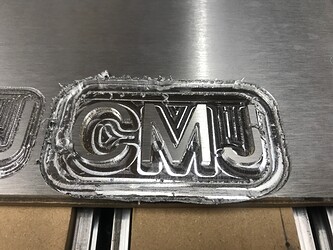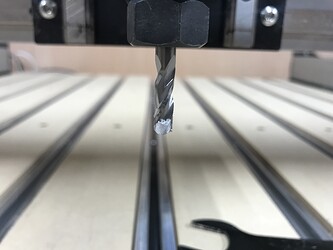I’ve attempted two small jobs with 6061 aluminum and both failed. I do not view that as a bad thing as it’s part of learning. The first one failed because I did not properly secure the material. That’s a pretty easy thing to correct.
What I’m trying to make is a paperweight with my initials as it seems like a good mix of tasks.
The cutters I’m using are stock carbide #102, #112, and #201.
Feeds & speeds are coming straight from Carbide Create making sure to select aluminum as the material and not the Z coated endmills.
Job two failed after the initial pocket was complete while doing the perimeter contour to release the piece using a #201.
Based on previous posts, my theory is that there was not proper chip extraction, things got hot, and the aluminum clogged the endmill. This resulted in it pushing material versus cutting. As it usually goes, I watched the entire job right up until 30 seconds or so before the failure and it was the sound of things that alerted me to something wrong happening. My reaction time was a little slow to hit the pause button so it made a good run around the perimeter before digging in.
I was able to build back some confidence with a simple job to mostly clean up the material using a #201.
Before I start on job three, I want to make sure that the corrections I make are heading in the right direction.
Correction 1
Improve chip removal from the work surface.
Correction 2
Find a font that is more suited for milling. Sharp angles, such as the inner part of the M, are a pain.
Correction 3
I do not know. Beyond buying endmills more suited for the task or learning the dark art of speeds and feeds, I would default to take things slow (speeds and feeds). However, if what I’ve read is correct, that might actually be the wrong thing to do if not properly done in conjunction with correction 1. If anything, I’m looking for confirmation that sticking with what’s in Carbide Create is the best thing to do for now as a beginner?
Thanks in advance!


